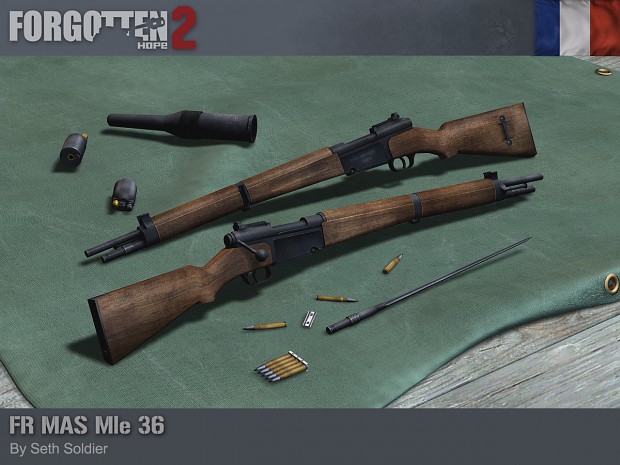Forgotten Hope 2 is an award-winning World War II modification for Battlefield 2TM and is based on the original Forgotten Hope, a modification for Battlefield 1942TM, one of the most popular multiplayer games ever. Battlefield 1942TM featured land, sea and air combat in a way never before seen. It was the goal of the development team to maximize the game experience by adding both a realistic and enjoyable gameplay to FH and now to FH2.
In the aftermath of the First World War, the French army started on a program to replace their ageing infantry weapons, and especially the obsolete 8mm Lebel cartridge. With the successful adoption of the 7.5mm cartridge and the FM 24/29 light machinegun to go with it, attention turned towards infantry rifles. It was decided that there would be 3 separate rifles produced in the new calibre: conversions of existing 8mm rifles as a stopgap, a semi automatic rifle to equip the standing army and a new bolt action rifle for the reserves.
By 1927, neither the conversion program or the development of the semi automatic rifle were progressing fast enough, so the reserve rifle became the priority. Approved in 1936, this new rifle was very much a product of the lessons of the First World War. Manufactured from only a few tens of parts, the MAS 36 was a cheap and quick to manufacture rifle that was capable of withstanding significant abuse. The rifle was supplied with a cruciform spike bayonet that was stored under the barrel and flipped around for use. It had a 5 round internal magazine, with a rear aperture sight and a thick front post protected by two wings.
Production of the MAS 36 started in 1937, and by the time of the German invasion about a quarter of a million had been produced. Despite having been intended as a rifle for the reserves, as the most modern rifle available they were mostly issued to the professional units. There was a version of the Viven-Bessières rifle grenade launcher made to fit the MAS 36. 1.1 million of the rifles would eventually be produced by 1952, with production resuming almost as soon as the Saint-Étienne factory was liberated in 1944. Ours was made by Seth Soldier.







Good job!
So in France campaign we finaly see tanks LT-38,LT-35 (Panzer 38,Panzer 35) from Czechoslovakia?
Funny situation France with Great Britain sold us in 1938 year during Munich Agreement and later France was defeated by our tanks and weapons that Germans taken from Czechoslovakia arms factories.
Quite an irony eh? Well, most people dont really know the history of ww2 at all or know it in quite a distorted and picky form and the story of "lesser" countries being played like pawns by allies is one of those aspects that are widely unknown and I have learnt not to pick too often. This subject is probably known in this community so You dont need to raise it :p And yes I also look forward to play some Skoda tanks.
Yeah.
Czechoslovakia was first country attacked by Germany and we had fight here around border against uprising of german minority nazi militias groups armed and supported by Nazi Germany.
So for Czechoslovakia war started earlier in September 1938.
I am always think that we may had defend ourselves and reject territory retreats for favor of Germany.
In this case Czechoslovakia will fight by self against Germany,later will probably join at german side Hungary,Poland and we had too fight against our hostility minorities lived here around borders.
We has in 1938 well fortificated borders with Germany,Austria it is probably better protected than Maginot lines and after mobilisation we has more than million well trained soldiers with very quality military equipment.
Wehrmacht in this time are weak.
So we had big chance stop aggresor or win.
Only our air force was weak, outdated against Luftwaffe but our pilots too was well trained...for example they was success in defend of Great Britain against Luftwaffe.
Exactly! Germany took down nations of similar productive/imported military industry and kept rolling along. Only thing that allowed it was the League of Nations not having the balls to stand against Hitler then, Just kept the appeasement train rolling along...